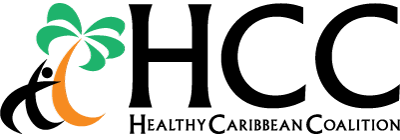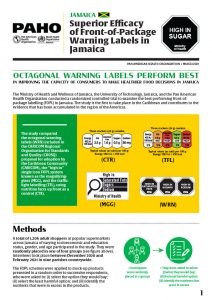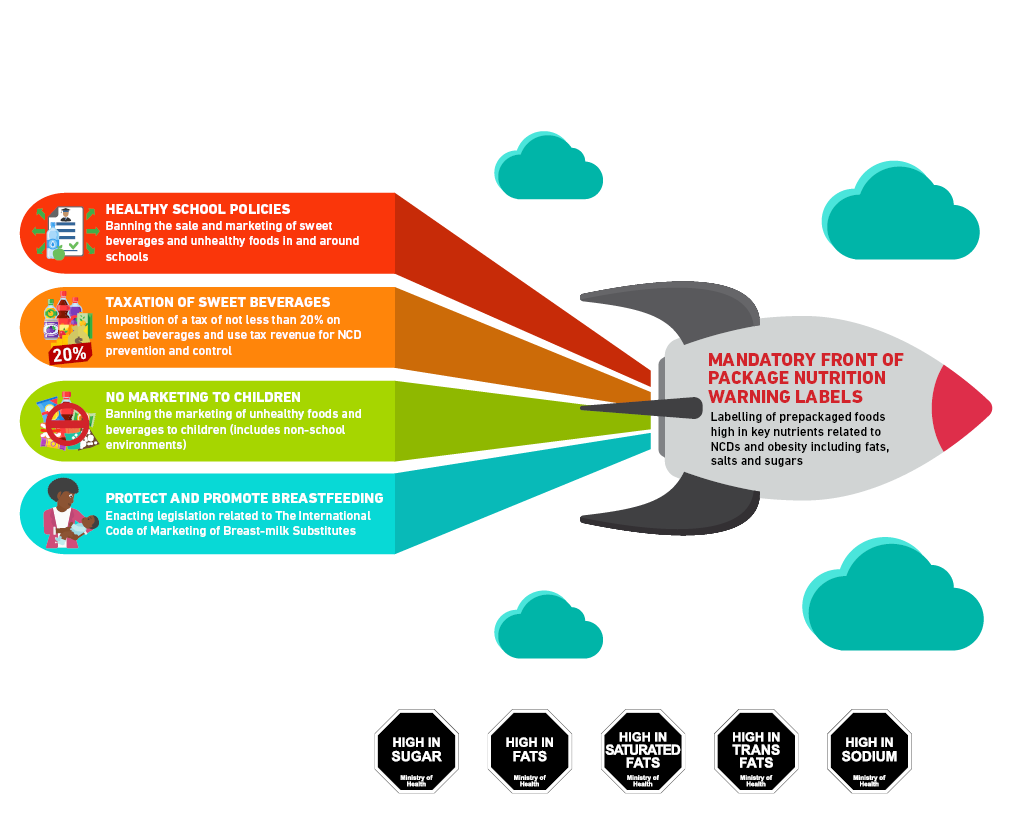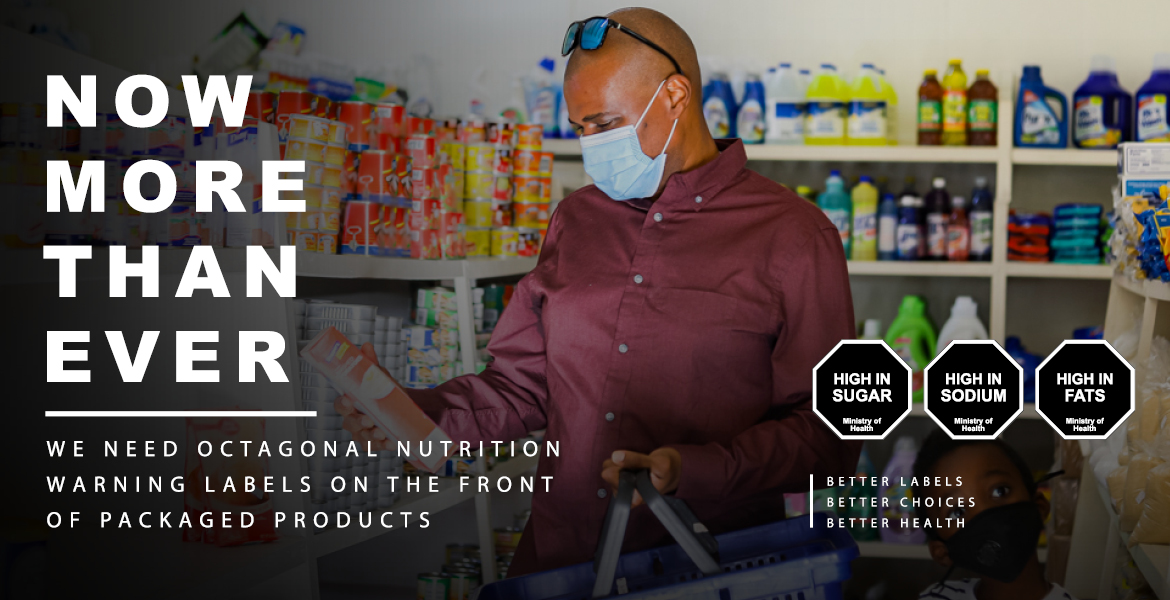
Front-of-Package Warning Labelling (FOPWL)
The HCC is committed to promoting healthy food policies which ensure that all Caribbean citizens including children and young people have access to healthy nutritious food. Front-of-package Warning Labelling is one such policy which HCC and our member CSOs across the region are advocating for as part of HCC’s broader regional programme of work to tackle the epidemic of Noncommunicable Diseases (NCDs) and the growing crisis of overweight and obesity among Caribbean children, as detailed in Civil Society Action Plan 2017-2021: Prevention Childhood Obesity in the Caribbean (CSAP). Given the strong link between severe COVID-19 illness and obesity, our FOPWL advocacy also forms part of the HCC COVID-19 Advocacy and Communication Strategy (of which one of the key objectives is to promote access to, and consumption of healthy foods); and supports the HCC/ OECS Joint statement on Strengthening Food and Nutrition Security in the Caribbean: A Legacy Response to the COVID-19 Pandemic.
Click on the links below to find out more.
- What Is Front-of-Package Warning Labelling (FOPWL)?
- Why Do We Need Front-of-Package Warning Labelling (FOPWL)?
- The Scientific Evidence To Support Octagonal Front-of-Package Warning Labelling (FOPWL)
- Front-of-Package Warning Labelling (FOPWL) – A Critical Part of Broader Strategy To Encourage Healthier Diets
- The Process To Develop a CARICOM Front-of-Package Warning Labelling (FOPWL) Standard
- Support for Front-of-package Warning Labelling (FOPWL)
- Press Releases
- Regional Media Coverage
- Now More Than Ever: Better Labels, Better Choices, Better Health Regional Campaign
- FOPWL Social Media Materials For Your Advocacy
- More information on FOPWL
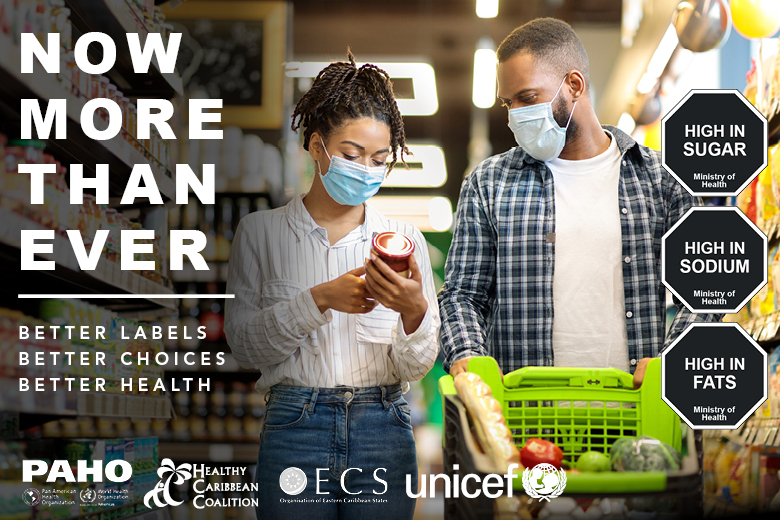 Regional campaign “Now More than Ever: Better Labels, Better Choices, Better Health” launched by The Healthy Caribbean Coalition (HCC) in collaboration with the Pan American Health Organization (PAHO), UNICEF and the OECS Commission to raise awareness about the impact of childhood overweight and obesity and the regional NCD epidemic, while promoting children’s right to nutritious foods and mobilising public and policymaker support for the adoption of the octagon shaped warning labels on the front of packaged foods as the best way to help Caribbean citizens identify products that are high in sugars, fats and salt.
Regional campaign “Now More than Ever: Better Labels, Better Choices, Better Health” launched by The Healthy Caribbean Coalition (HCC) in collaboration with the Pan American Health Organization (PAHO), UNICEF and the OECS Commission to raise awareness about the impact of childhood overweight and obesity and the regional NCD epidemic, while promoting children’s right to nutritious foods and mobilising public and policymaker support for the adoption of the octagon shaped warning labels on the front of packaged foods as the best way to help Caribbean citizens identify products that are high in sugars, fats and salt.
What Is Front-of-Package Warning Labelling (FOPWL)?
- Front of package warning labels (FOPWL) are labels or seals applied to the front of packaged products which allow consumers to correctly, quickly and easily identify when a product contains excessive amounts of critical nutrients. Critical nutrients of public health concern are: sugars, total fats, saturated fats, trans fats and sodium. These nutrients when consumed in excess are linked to obesity and NCDs, in particular high blood pressure, high fasting blood sugar levels and overweight/obesity.
- The actual front-of-package text-based seals are placed in the main panel visible to the consumer to indicate if the product is “HIGH IN SUGAR”, “HIGH IN SODIUM”, “HIGH IN SATURATED FATS”, “HIGH IN TOTAL FATS”, and/or “HIGH IN TRANS FATS”.
- Nutrient profile models are used to establish the thresholds that define when these critical nutrients are in excess.

- For more information visit PAHO’s dedicated FOPWL webpage which contains Frequently Asked Questions and links to important resources such as the PAHO Publication – Front-of-Package Labeling as a Policy Tool for the Prevention of Noncommunicable Diseases in the Americas.
Why Do We Need Front-of-Package Warning Labelling (FOPWL)?
- High blood pressure, high fasting blood sugar levels and overweight/obesity are the top three risk factors for mortality in the Americas.
- Noncommunicable diseases (NCDs) are the leading causes of mortality, morbidity and disability in the Caribbean. In all of the Americas, the Caribbean has the highest rates of NCD mortality.
- Rates of overweight and obesity in the region are among the highest in the world and most worrying among children where 1 in 3 children and teens is overweight or obese.
- Unhealthy diets pose a greater risk to morbidity and mortality than tobacco use, alcohol use and unsafe sex combined. Unhealthy diets are a major risk factor contributing to the high rates of obesity and NCDs; and are fueled by the widespread availability and consumption of processed and ultra-processed products which contain high levels of “critical nutrients”, namely sugars, total fats, saturated fats, trans fats and sodium.
- COVID-19 has underscored the urgent need to invest in evidence-based policies and programmes aimed at preventing and treating obesity and NCDs.
Front-of-Package Warning Labelling (FOPWL) – A Critical Part of Broader Strategy To Encourage Healthier Diets
- Front-of-package warning labeling (FOPWL) is a key policy as part of a broader healthy food policy package aimed at combatting obesogenic environments which lead to overweight and obesity in children and diet-related NCDs more generally.
- FOPWL is an enabling policy that allows governments to more easily introduce important complementary policies including those which protect children from the sale and marketing of unhealthy foods and which make healthy foods more affordable and accessible for families.
The Process To Develop a CARICOM Front-of-Package Warning Labelling (FOPWL) Standard
- The CARICOM Regional Organisation for Standards and Quality (CROSQ) is undertaking the revision of the (2010) CARICOM Regional Standard for Specification for labelling of pre-packaged foods (CRS 5:2010) to incorporate FOPWL specifications.
- This process was initiated in 2018 and is being led by a Regional Technical Sub-committee (RTSC) comprised of representatives of eleven (11) Member States (MS) (Antigua and Barbuda, Barbados, The Bahamas, Dominica, Guyana, Haiti, Jamaica, Saint Kitts and Nevis, Saint Lucia, Suriname and Trinidad and Tobago).
- The RTSC has been responsible for disposing and consolidating comments received from the National Bureaus of Standards (NBSs) in all CARICOM MS (Antigua and Barbuda, Bahamas, Barbados, Belize, Dominica, Grenada, Guyana, Haiti, Jamaica, Montserrat, Saint Kitts and Nevis, Saint Lucia, Saint Vincent and the Grenadines, Suriname, and Trinidad and Tobago), which have engaged in several rounds of extensive consultations with all relevant stakeholders.
- In January 2021, the RTSC completed a Final Draft CARICOM Regional Standard (FDCRS) that has been submitted for voting to all CARICOM MS during the period 17 February- 14 April, 2021. At country level, the voting process will be facilitated by the National Bureaus of Standards through consensus building with all stakeholders.
- If the Final Draft CARICOM Regional Standard (FDCRS) is supported by at least three quarters of all MS, the FDCRS will then be submitted to the CROSQ Council for approval, and then presented to CARICOM Council of Trade and Economic Development (COTED) for final endorsement.
- The current FDCRS meets the highest level of scientific rigor, including octagon-shaped warning labels indicating if a product is “HIGH IN” one or more critical nutrients, and the PAHO nutrient profile model (PAHO NPM) to establish the thresholds that define when these critical nutrients are in excess.
Support for Front-of-package Warning Labelling (FOPWL)
- Political Support
- Front of Package Warning Labelling is supported by strong regional mandates, including the 2007 Port of Spain Declaration, the CARPHA 6-Point Policy Package approved by Heads of Government, and the communiqués of the 37th and 39th Conference of Heads of State and Government.
- More recently, Primer Minister and Chairman of CARICOM, Dr. the Hon Keith Rowley of Trinidad and Tobago, noted in this Statement at the CARICOM 32nd Intersessional Heads of Government Meeting that “We need to redouble our efforts in addressing NCDs and exploring their nexus with food and nutrition security”, and hoped for deliberations on Advancing the Regional Agenda on Food and Nutrition Security to assist in this regard. Read the full statement here.
- It has also been noted as a rights-compliant response in a recent Statement by the UN Rapporteur on the Right to Health, which highlights States’ obligations to adopt regulatory measures aimed at tackling NCDs.
- Statement on Front of Package Warning Labelling by Dr Shana Cyr-Phillbert Senior Medical Officer Non-Communicable Diseases – Saint Lucia Ministry of Health
- Dr. Chris Tufton | Consumers have a right to know what’s in their food in keeping with the right to good health
- Health Minister Welcomes ‘Right To Know’ Campaign
- Jamaicans have a right to know what’s in their food – HFJ
- Minister of Foreign Affairs and Foreign Trade Barbados – HCC Sings High Praises for Barbados Minister in Ministry of Foreign Affairs and Foreign Trade, Sandra Husbands’ Commitment to Front of Package Warning Labels
- Civil Society Support
- Healthy Caribbean Coalition and Partners Statement of Support for Octagonal Front-of-Package Warning Labels
- Caribbean Academics, Researchers and Health Practitioners Support Octagonal Front of Package Warning Labels
- Statement of Support from the Caribbean Association of Dieticians and Nutritionists (CANDi)
- Open Letter from Caribbean Pediatricians which expresses support for FOPWL
- Expert Open letter in response to assertions of the Jamaica Manufacturers and Exporters Association
- Suzanne Soares-Wynter | We have a right to know what is in our food
- Researcher Wants Nutrition Labels That Can Lead To Healthier Food Choices
- EDITORIAL: FOR THE HEALTH OF OUR PEOPLE
- HCC PRESIDENT: MEDIA HAS ROLE TO PLAY IN NUTRITION LABEL PUSH
- Maisha Hutton | Put public health before industry profits
- Joint statement with National Consumers League Jamaica
- Statement from the Jamaica Association of Professionals in Nutrition a Dietetics (JAPINAD) in Support of Octagonal Front-of-package Warning Labels
- Rotary District 7030 supports Front of Package Labelling
- Statement from the Caribbean Policy Development Centre (CPDC) in support of octagonal front-of-package warning labels
- Dominica Cancer Society supports front-of-package warning labels for packaged foods
Press Releases
- Hundreds of Caribbean Health Professionals, Regional Organisations Support Front of Package Warning Labels for Foods
- HCC Advertorial – May 14, 2021
- WORLD RENOWNED RESEARCHERS CALL ON GOVERNMENTS TO ACT NOW AND IMPLEMENT EFFECTIVE HEALTHY FOOD POLICIES
- A call to Caribbean leaders for introduction of octagonal front-of-package warning labelling to tackle obesity
- Healthy Caribbean Youth (HCY) Urging CARICOM to Implement Octagonal High In Front-of-Package Warning Labelling (FOPWL)
- Local, Regional Researchers Provide Evidence About Jamaicans’ Preference for Front of Package Warning Labels
- PAHO, HCC, OECS, UNICEF launch “Now More Than Ever” regional campaign promoting Front-of-Package Warning Labelling
- PAHO urges support for CARICOM for front-of-package warnings against unhealthy food
- Big Food Used Global Pandemic to Aggressively Promote Unhealthy, Ultra-Processed Food & Sugary Drinks
- STUNNING OUTCOME ADMIDST COVID-19 AS MEXICO AND CHILE DELIVER HEALTHY RESULTS ON POLICIES FOR FRONT OF PACKAGE LABELLING ON PACKAGED FOODS AND BEVERAGES
Regional Media Coverage
- July 7, 2023 – Food Warnings Soon
- March 8, 2022 – High-in labelling still the best choice
- February 4, 2022 – Standard for nutrition labels imminent
- October 4, 2021 – CARPHA: Caribbean people have a right to know what is in their food
- September 11, 2021 – Jamaicans have a right to know what’s in their food – protect this right!
- September 6, 2021 – Influencing healthy consumer behaviour is our priority
- September 4, 2021 – Front-of-package warning labels are a tool to protect consumers’ rights and health
- August 26, 2021 – Will the Caribbean’s Ronaldo please stand up? Region needs athletes in support of healthy food policies
- August 15, 2021 – Front-of-packaging labelling – Jamaican consumers trumped by vested interests
- July 25, 2021 – Front-of-pack labelling: interests, myths, and scientific evidence
- June 15, 2021 – Deborah Chen | Is evidence being ignored in front-of-package labelling
- June 11, 2021 – Front-of-package warning labels – CARICOM can either follow science or protect private interests
- May 28, 2021 – JCN TV NEWS
- May 27, 2021 – Dominica Cancer Society supports front-of-package warning labels for packaged foods
- May 26, 2021 – Front of package warning labels to help curb NCDs
- May 26, 2021 – Caribbean Health Professionals, Regional Organisations Support Front of Package Warning Labels
- May 22, 2021 – ALL Caribbean consumers regardless of age, education, income or job, can benefit from the adoption of nutrition warning labels!
- Front of package warning labels crucial | Professor Emeritus Sir Henry Fraser
- May 12, 2021 – CARICOM needs healthy food policies
- May 11, 2021 – Maisha Hutton | CARICOM member states need healthy food policies now
- May 6, 2021 – Act Quickly | Time to implement healthy food policies
- May 4, 2021 – Experts call for urgent response to NCDs
- April 25, 2021 – Health advocates push for labelling
- April 11, 2021 – Antigua Joins Other CARICOM Countries in a Silent Call to Action to Standardise Front Package Labelling
- April 10, 2021 – Front-of-Package Warning Labelling (FOPWL) Key Messages
- April 10, 2021 – Healthy Caribbean Youth urges CARICOM members to improve standard of package warning labels
- April 8, 2021 – Label warning new frontier against NCDs
- April 8, 2021 – Healthy food choices, a child’s right
- April 8, 2021 – ‘Fight for nutrition warnings with pandemic urgency’
- April 8, 2021 – Front of Package Nutrition Warning Labelling should be mandatory
- March 25, 2021 – Health advocate zeroes in on ministers ‘lukewarm’ stance on nutrition label
- March 20, 2021 – Nutrition labels ‘not bad for business’, food, drink makers told
- March 11, 2021 – EDITORIAL: FOR THE HEALTH OF OUR PEOPLE
- March 9, 2021 – Suzanne Soares-Wynter | We have a right to know what is in our food
- March 8, 2021 – Researcher Wants Nutrition Labels That Can Lead To Healthier Food Choices
- March 5, 2021 – Health Minister Welcomes ‘Right To Know’ Campaign
- March 4, 2021 – Jamaicans have a right to know what’s in their food — HFJ
- March 4, 2021 – HFJ pushing for front-of-package labelling to fight NCDs
- December 19, 2020 – ‘YES’ TO NUTRITIONAL WARNINGS ON FOOD PRODUCTS
- December 7, 2020 – HCC President: Media Has a Role to Play in Nutrition Label Push
- November 12,2020 – Increased push for Increased push for front-of-package labelling
- November 11,2020 – Health Ministry Prioritises Food Labelling in Battle Against NCDs
- October 18, 2020 – Maisha Hutton | Put public health before industry profits
- October 2, 2020 – Heart Foundation of Jamaica welcomes front-of-package label guidebook
- August 6, 2020 – Food warning labels good for your health, says Healthy Caribbean Coalition
More on Front-of-Package Warning Labels
[1] Pan American Health Organization. Front-of-package labeling as a policy tool for the prevention of Noncommunicable Diseases in the Americas. Available here: https://iris.paho.org/handle/10665.2/52740
[2] An evaluation of Chile’s Law of Food Labeling and Advertising on sugar-sweetened beverage purchases from 2015 to 2017: A before-and-after study (plos.org)
[3] Predicting obesity reduction after implementing warning labels in Mexico: A modeling study (plos.org)
[4] Pan American Health Organization. Superior efficacy of Front-of-package Warning Labels In Jamaica. Available from: https://iris.paho.org/handle/10665.2/53328
